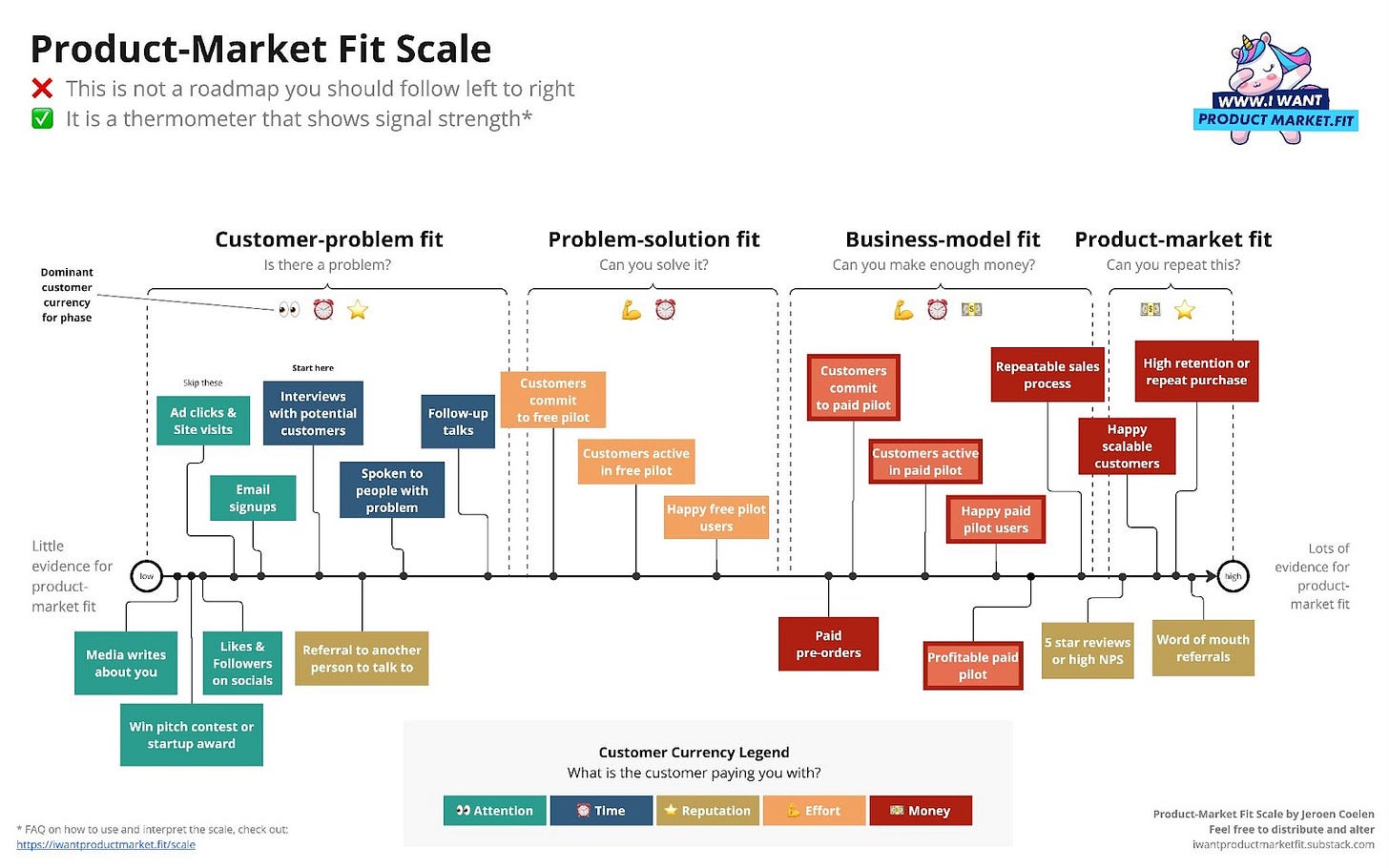The Product-Market Fit Guide: How to Achieve PMF 🔑
A Step-by-Step Playbook to Achieve PMF (Product-Market Fit) for Startups
Product-market fit (PMF) is the holy grail of startups. It’s the milestone that validates your product’s desirability, profitability, and scalability. Without it, you’re just guessing. With it, you’re positioned for exponential growth.
However, achieving PMF is hard, and most startups fail because they focus on the wrong things or tackle problems in the wrong order. So how do you get there?
This week’s guest article is by Jeroen Coelen, founder of the Substack "I Want Product-Market Fit" and a startup expert who has worked with over 300 companies
As an ex-founder, designer, and "startup scientist," Jeroen shares his proven playbook to achieve PMF (Product-Market Fit) and navigate early-stage challenges
What is Product-Market Fit?
I love Lenny’s definition of PMF:
A highly desirable product, for which you can find and keep customers sustainably, while making a profit delivering the product at scale.
It’s simple to say, but the journey to PMF requires structured, deliberate steps.
The Product-Market Fit Scale
Not all signals are equal. Some are weak indicators, while others are strong signals of true PMF.
Weak Signals: Vanity metrics like website visits, social media likes, or PR mentions.
Strong Signals: High customer urgency, willingness to pay full price, and repeatable sales motions.
Focus on achieving the strong signals first. The rest will follow.

A Step-by-Step Playbook to Achieve PMF
This playbook, based on insights from working with over 300 startups, is designed to help you systematically navigate the journey to PMF.
Step 1: Check Customer-Problem Fit
Customer-problem fit is the foundation of PMF. If no one urgently needs your solution, your product is doomed to fail.
How to find it:
Identify potential customers with "hair-on-fire" problems they need to solve now.
Skip vanity signals like creating websites or collecting likes—focus on conversations.
Speak to 10-50 potential customers. Out of these, find 1-3 who are truly desperate for a solution.
💡 Pro Tip: Your first customers might be in your phone’s contact list.
Step 2: Check problem-solution fit
Once you’ve identified urgent problems, test if your solution resonates.
Steps to validate problem-solution fit:
Create a brochure that clearly explains your value proposition.
Share it with the 1-3 high-urgency customers. Gauge their reaction.
Propose a pilot using the Startup Pilot Canvas.
Charge a discounted fee to ensure customers have skin in the game.
After running the pilot, interview your customers to understand what delighted them and what didn’t.
Step 3: Check business model fit
Now it’s time to see if your solution is financially sustainable.
Key questions to answer:
Can you charge enough to cover your costs, including customer acquisition?
Are customers willing to pay full price for your product?
How to test it:
Do 100-500 outreaches to potential customers.
Run paid pilots at full price.
Iterate based on customer feedback.
💡 Goal: Secure 5 happy customers paying full price. These are the seeds of PMF.
Step 4: Check product-market fit
Finally, you’re ready to scale.
Steps to solidify PMF:
Analyze your 5 happy customers. Identify common traits (role, company size, pain points).
Define your beachhead market—the segment you’ll target first.
Formalize your sales process based on repeatable sales motions.
Execute the process 10-50 times, refining and automating as you go.
💡 Pro Tip: PMF isn’t static. Keep iterating based on customer feedback and market conditions.
Common Pitfalls on the Path to PMF
Skipping Steps: Don’t jump to scaling before validating problem-solution or business model fit.
Focusing on Vanity Metrics: Website visits or social media likes don’t indicate PMF.
Over-automating Early: Build processes manually first, then automate once they’re proven.
Key Takeaways
Product-market fit means creating a desirable, profitable, and scalable product.
Follow a phased approach: Customer-problem fit → Problem-solution fit → Business model fit → Product-market fit.
Validate each step thoroughly before moving to the next.
Final Thoughts on PMF
Achieving PMF is hard, but it’s the most critical milestone for any startup. It’s not just about building a product—it’s about building the right product for the right audience at the right time.
What’s your biggest challenge in reaching PMF? Let’s discuss in the comments.






This guide is a great for founders seeking clarity. Thanks!
great post